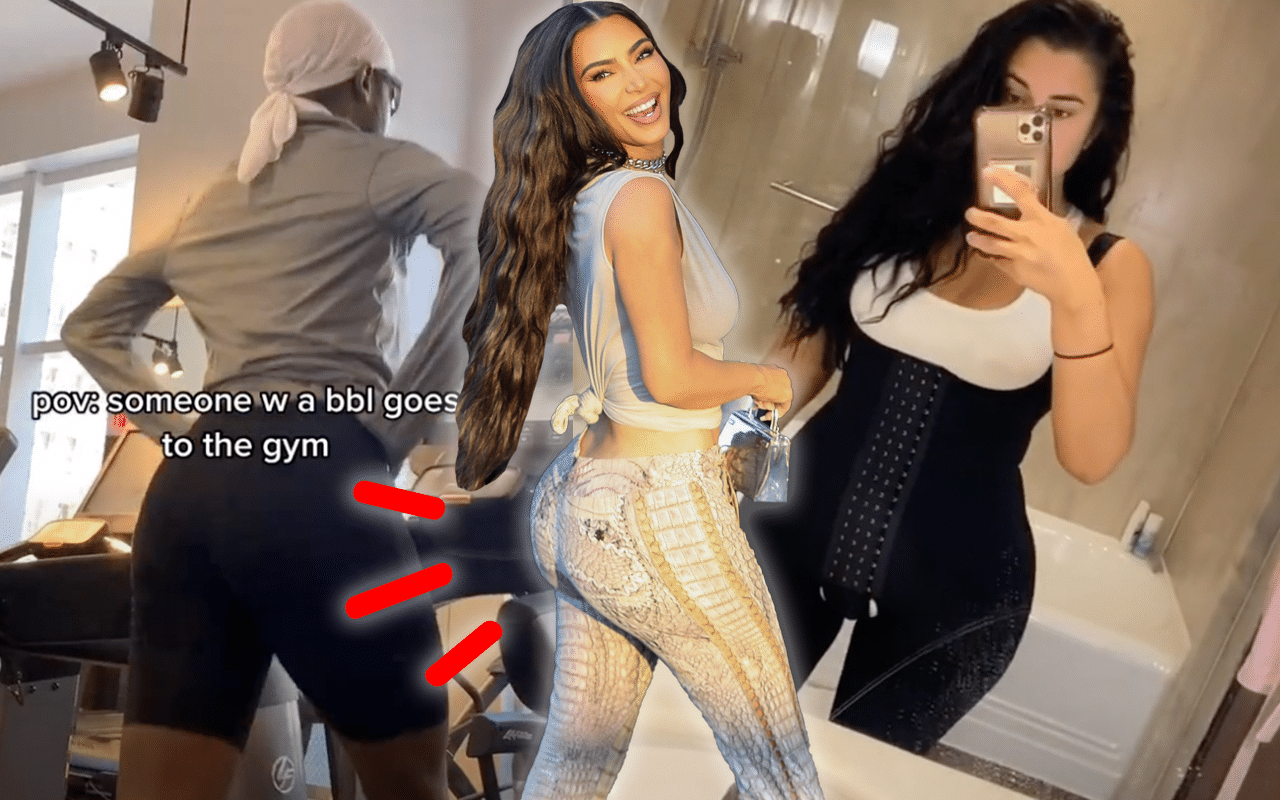
If you’ve noticed a series of videos hashtagged #BBL or #BBLjourney pop up on your FYP, you’re not alone. It seems a new “side” of TikTok has emerged, one with a focus on BBLs and the glorification of this plastic surgery. But what even is a BBL? And why has it become TikTok’s next big thing?
BBL stands for ‘Brazilian Butt Lift’
Short for ‘Brazilian Butt Lift,’ a BBL is a fat transfer operation that removes fat from one part of the body and injects it into the thighs, hips, and butt for a more voluptuous look.
Like almost everything online, TikTok’s obsession with BBLs started as a meme.
In late April, TikTok creator @antonibumba went viral for satirising what can only be described as post-BBL energy. For those unfamiliar with the latest trend to sweep the app, Antoni and thousands of users are poking fun at BBL recipients by associating the procedure with specific mannerisms and behaviour.
Shared under #BBLeffect, the trend involves creators placing their post-BBL alter ego in everyday situations. As NYLON‘s culture editor Layla Halabian writes, “Bumba’s BBL Effect character is a bad b*tch incarnate (with) a haughty attitude (and) immaculate hair and makeup.” While undertaking the most ordinary of tasks, like working out or catching an Uber, the BBL Effect character has a certain flair. It is simply their world and we are just living in it.
“POV: Someone with a BBL just got some bad news,” the text reads as Antoni uses a tissue to dry their tears and a spoolie to brush through their lashes. Sure, they may cry now and then, but the TikToker’s alter ego is prepared for a touch-up at any moment. Even at the saddest of times, they continue to exude a sense of unattainability, confidence, and bitchiness (in the best way possible, of course).
At the time of publication, the #BBLeffect trend has accumulated over 93 million views. Thanks to its popularity, the video-sharing app has started boosting content showing the before-and-after stages of a BBL.
Many users have expressed concern with the platform’s choice to promote cosmetic procedures. So, let’s explore why…
Why is it harmful for TikTok to promote BBLs?
Teenagers and children make up the majority of TikTok’s active users. Statista estimates that the under-19 age group constitutes 25% of its US user base. In fact, The New York Times claims one-third are under the age of 14. With such a young demographic, it is unsettling that the platform trivialises intense cosmetic procedures through trends like the #BBLeffect. Among those concerned are YouTube commentary channels Madisyn Brown and ItzKeisha, who insist that TikTok’s power to shape impressionable young minds is fuelling the “BBL epidemic.”
While the phrase “BBL epidemic” may seem like an exaggeration, it isn’t far from the truth. According to the American Association of Plastic Surgeons, BBLs have “an alarming rate of mortality, estimated to be as high as 1 in 3,000, a rate of death far greater than any other cosmetic surgery.”
Of course, there are health risks associated with any aesthetic procedure. However, with many BBL patients travelling abroad to get the surgery at a reduced price, health risks intensify. Often standards of care are not regulated, and health complications are not covered by insurance. The same can be said for patients who get BBLs done by underqualified practitioners working in non-approved facilities, such as homes and garages.
As Madisyn rightly claims, the BBL is a “death trap.”
TikTok creators, such as plastic surgery resident Emily Long, have since taken to the platform to raise awareness about the reality of BBLs.
In multiple videos, she explains how doctors without surgical training can take weekend courses to legally perform the procedure. Instead of going to board-certified plastic surgeons with years of training, “patients go to them because it’s cheaper” @dr.ems writes.
Needless to say, this increases the likelihood of health complications post-op.
So, why are people still getting BBLs?
Simply put, BBLs fit in with the current beauty standard. After watching the Kardashian-Jenner clan turn their bodies into billion-dollar brands, tight tummies and exaggerated hourglass figures have become the blueprint.
As Andria Moore writes for BuzzFeed, “The big-bottomed obsession has a direct correlation to Kim Kardashian’s rise to fame. When Kim first broke into Hollywood in the early 2000s, all anyone could talk about was her butt.” While Kim has benefited from her iconic figure, Black women have long been stigmatised for the same traits. The fascination with her curves serves as a reminder of the exploitation of Black women’s aesthetics and beauty in popular culture.
“Between their loyal viewership on television and massive social media presences…the family blazed a trail for a new model of celebrity: the influencer” explains Cady Lang in Time Magazine. With Kim able to convince audiences that she is an exotic white woman, the Kardashian-Jenners have changed the way society perceives bodies and beauty through social media. Take Kim’s 2014 Paper Magazine cover, for example. After her notorious cover “broke the internet,” the interest in BBLs grew exponentially, seeing a 77.6% increase since 2015.
The cover was quite literally a cultural reset.
Social media platforms have continued to promote the “Kardashian Aesthetic.” As Facetuned bodies and BBL-related videos flood our Instagram feeds and TikTok FYPs, many of us have become accustomed to plastic surgery. As odd as it may sound, bodies perfectly sculpted by BBLs have almost become the new “natural.” With social media perpetuating unrealistic beauty standards, many users suffer from body image issues and low self-confidence. Nevertheless, these platforms glamorise surgically altered bodies and exploit the fragile self-esteem of their users, padding the pockets of plastic surgeons and the influencers who promote them.
With this, BBLs have become an increasingly popular procedure for young girls.
TikTok user @RoxanneRamsey went viral after explaining her experience helping a friend through the BBL recovery process. She said she was shocked to see so many young women getting the procedure. “Literally it was 30 chairs in the waiting room and every single chair was taken up” she went on to say, “It was like a trap house for BBLs.”
In a beauty-obsessed society, the line is often blurred between what we want our body to look like and what we think we need to be beautiful. While plastic surgery can certainly provide positive results for patients, there is a lot to be said for the ever-evolving beauty standard. What was trendy a decade ago isn’t trendy now, and the same will likely ring true for the BBL look in years to come.
So as we wait for the body trend to change, one sad truth remains the same: young women have been killing themselves to meet the beauty standard for centuries. And the BBL epidemic has become one of the most deadly standards of all.

